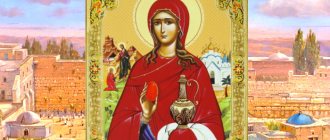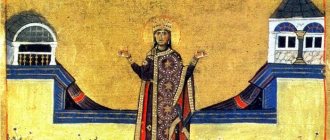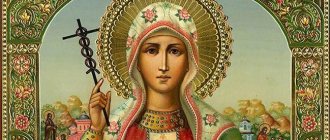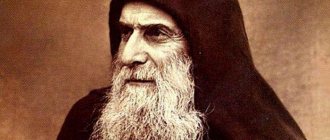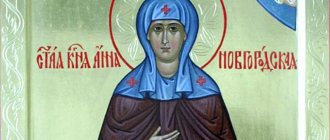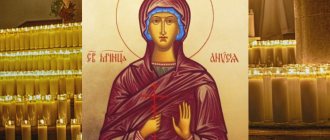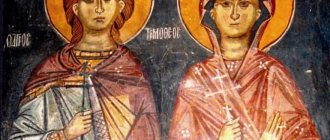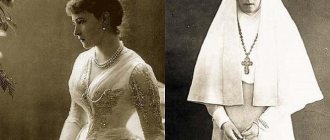The prayers of the Mother of God - Holy Righteous Anna - have always been considered one of the strongest. Saint Anne is the mother of the Virgin Mary. Thousands of believers come to her icon asking for help. Saint Anna experienced a lot of suffering in her life and therefore tries to help everyone who is having a hard time. You can ask Anna for anything; many believers claim that the prayer of the mother of the Most Holy Theotokos Anna will definitely be heard.
Memorial Days:
- August 7 – Assumption
- September 22nd
- December 22 – Conception of the Blessed Virgin Mary
Holy Righteous Anna the Prophetess
Saint Anna the Prophetess glorified her name with the birth of the prophet Samuel, who was born thanks to his mother’s fervent prayers addressed to God. This miracle happened 1100 years before the birth of the Savior Jesus Christ.
Life of Anna the Prophetess
Anna was born in the ancient city of Armaefma, which cannot be found on a modern map of Israel. In due course she married Elkanah, a man who lived on Mount Ephraim in the area of Ramathaim-Zophim. They say that this place was located northwest of Jerusalem.
The couple did not enjoy the happiness of family life for long. The woman was infertile and could not get pregnant for many years. In those days in Israel, families in which they could not conceive a child were treated poorly. They believed that God does not show mercy to the family. Anna had a hard time because of the ridicule and reproaches of her neighbors. Her husband loved her dearly, but could not resist evil tongues and shame.
Elkan took into the house a second wife who could give birth. Fennana gave her husband children, and Anna suffered humiliation and suffered from the malicious remarks of others. The barren woman found solace in constant prayers. There were no temples nearby, and she went to the tabernacle - a tent that served as a church.
On one of the holidays, driven to despair by reproaches, a woman ran into the tabernacle in tears, threw herself on her knees and began to silently pray in tears, and only her lips moved. She paid no attention to the clergyman. Anna passionately promised to give her son to the Lord of hosts if he would let her experience the joy of motherhood.
This prayerful appeal to God continued for a long time until the priest Eli drew attention to the woman. He found this behavior strange and unacceptable. The bishop approached Anna and wanted to drive her out of the tabernacle. The woman meekly and humbly explained her behavior and told about her misfortune.
Eli sympathized with the woman and reassured her that the prayer was heard by God. And so it happened. Soon the happy parents found a son, calling him Samuel. From adolescence he devoted his life to serving God. He is remembered as the prophet of Israel. Anna gave her husband five more children. Three sons and two daughters continued their glorious family.
Anna became a caring and deeply loving mother for her children.
The prophetess lived to a ripe old age, revered and respected by her husband and children.
Samuel became an adopted son and heir for the high priest Eli. His half-parents visited him once a year, brought him new clothes and donated them to the altar of the church.
Memorial Days
The holiday of Candlemas or Winter Solstice falls on December 22. It is on this day that the Christian Church honors the memory of the righteous Anna the Prophetess, the mother of the prophet Samuel.
Veneration of the ascetic
On the first icons, the wise old woman was depicted as a gray-haired woman with a gaunt, thin face, dressed in a tunic, a phelonion (the outer vestment of an Orthodox priest) and a head veil worn by widows. As a rule, she (full face or in profile) was located behind the back of the Virgin Mary, pointing to Jesus Christ with her right hand.
Later, masters began to create individual relics. On them, the righteous woman holds a scroll, where words about the deliverance of all living in Jerusalem or a line from the Christian missal: “He who created heaven and earth” are inscribed in Church Slavonic or Greek. You also have the opportunity to buy an icon of St. Anne with another of its attributes - a candle.
The memory of the ascetic is celebrated on September 10 (according to the old style - August 28). In addition, the chapter from the Gospel, which describes the deeds of the righteous woman, is read on Candlemas (February 15), and she herself, together with Simeon the God-Receiver, is remembered on the post-feast day, February 16.
History of the icon
The first icons dedicated to the mother of the prophet Samuel appeared in the Byzantine Empire. One of the biblical miniatures from the eighth century depicts Elkan and his two wives. Fennana stands with the children, and Anna, in grief and sadness, is alone. This scene is a vivid reflection of the suffering of a childless woman. Other miniatures tell about the birth of the son Samuel and his transfer to the priest Eli.
Artists often painted Anna in heartfelt prayer. One of them was Andrei Petrovich Sapozhnikov, who depicted a kneeling saint in 1861. Another painting, painted in 1668, is in the Louvre; it belongs to the hand of the Dutch artist Gerbrand van den Eeckhout. In it, the saint introduces Samuel to the priest Elijah.
Strong prayers before the icon of the Holy Prophetess Anna
Prayers before the icon of the pious Anna have amazing power. The saint helps all believers who sincerely ask for intercession and help.
First prayer
The troparion is dedicated to the Prophetess Anna, tone 2:
In memory of Your prophetess Anna, O Lord, in celebration, we pray to You: save our souls.
Second prayer
In the kontakion, tone 4, the pure heart of the mother of the prophet Samuel is glorified:
Your pure heart, enlightened by the spirit, the prophecies have become your brightest friend: see that the real one exists far away. For this reason we honor you, blessed prophetess, glorious Anno.
Prayer for infertility
Desperate women, in an effort to know the joy of motherhood, read a prayer against infertility in front of the holy image.
“Holy saint Anna the Prophetess! With your feat, you proved your devotion to our Lord Almighty and spent a righteous life in fervent prayers. Pray, holy one, for our foolish children, so that their illnesses and any evil may be left behind. Grant the childless the joy of motherhood and protect everyone from dashing evil and unkind deeds. Offer prayers to the Lord, so that he may send his blessing upon us and not reject our sincere requests and repentance. Intercede, Anna, for the children of God, so that they are not tormented by illness, sorrow, or the evil thoughts of envious people and ill-wishers. Amen".
Preface
The list of holy women with the name Anna is opened by the holy prophetess Anna, the mother of the prophet Samuel, and the holy righteous Anna the Prophetess, daughter of Phanuel, from the tribe of Asher. We learn about the first of them from the Old Testament, and about the second from the New Testament. The name Anna was also borne by the holy mother of the Divine Maiden, who was especially revered in Rus' from ancient times. In her name, a large number of churches were built and many monasteries were created.
Almost all canonized wives of Ancient Rus' are princesses. From the first centuries of Christianity in the Russian land, God's Providence imposed on them a special feat - to show their sisters examples of Christian femininity, to stand as a burning and shining lamp
(John 5:35), a candle on a candlestick and give light to everyone in the house (see: Matt. 5:15).
For the 10th – first half of the 16th centuries, the content of the female religious and moral ideal was the idea of chaste marriage combined with the idea of concelebration in power. The idea of the inextricable connection between the sanctity of marriage and sacred royal power became the essence of women's religious and moral ideal from the middle of the 16th to the first quarter of the 17th century. This idea served as the basis for the life of the Venerable Princess Anna Kashinskaya. In the Life, the image of the holy princess Anna Kashinskaya reflects the confessional feat of her husband, Prince Mikhail Alexandrovich, and monastic service associated with the political mentoring of her sons.
The noble princesses of Rus', having become widows, did not marry a second time, although the Church did not prohibit second marriage. Monastic tonsure - betrothal to the Heavenly Bridegroom - became the path that most corresponded to the ideal life of a widow. Therefore, the tonsure of widows among princes and boyars became almost a rule. The Church decorated the completed feat of married life with the monastic rite. The nun princesses set an example for the Russian people of the worthy completion of monogamy.
From the history of the Church in Rus' it is clear that from the princely families, women took on the yoke of monasticism before men. First of all, the wife of Grand Duke Yaroslav, Irina, monastically Saint Anna, took monastic vows. The second nun, and the first virgin from the princely family, was Blessed Anna, daughter of Vsevolod. She took monastic vows in 1086, while the first voluntary monk among the princes was Saint Nicholas Svyatosha, who entered the monastic monastery in 1106.
Women's monasteries began to emerge in Rus' in the 11th century. At first these were “clitoral” monasteries, that is, monasteries founded by great or appanage princes or even archbishops, of their own free will and understanding, by vow or for someone’s salvation. They were “singular”, that is, where each member of the community lived as he wanted. Such monasteries did not have a special monastic charter; they could even be common - monks and nuns lived in the same monastery. Only in 1504 did the Church Council prohibit such monasteries, and a statute for female monasticism was developed.
Noble Russian women were distinguished by their high education, determination, and desire to independently manage their destiny and arrange it based on their own beliefs, principles and personal interests. Thus, some of the young girls choose the monastic path for themselves and become the founders of monasteries, builders of churches, create schools to teach girls all kinds of sciences, engage in healing, read sermons to parishioners seeking answers to important questions. At that time, noble girls often received a better education than their boy peers, who were primarily trained in the arts of war. Girls were taught literacy, mathematics, the basics of philosophy, rhetoric, “medical tricks,” “calendar astrology,” singing and foreign languages.
In terms of property, many noble women were completely independent of their husbands. Husbands allocated entire cities for the maintenance of foreign women; Russian princesses received villages, land and even small towns from their fathers. This made it possible to have significant personal funds, carry out trade operations, engage in charity work and church construction. The independent position of many princesses is indicated by their personal seals, which they used to seal various documents.
In connection with the compilation of codes of laws, the name of Anna Romanovna, the wife of Vladimir Svyatoslavich, appears in the 10th century, and in the 13th–14th centuries - Anna Vsevolozha in Novgorod. The signatures of the Ryazan princess Anna and Ivan III under the treaty between Moscow and Ryazan of 1496 are equal. Most of the princesses were characterized by peacekeeping missions. Princess Anna Vsevolozhaya and Rostov princess Anna Dmitrievna advocated ending internecine bloody conflicts. These women were not canonized, but they did a lot for the Christianization of Rus'.
A major role in the history of Rus' was played by Princess Anna Romanovna, or Anna of Byzantium, the sister of Emperors Vasily II and Constantine VIII, and Anna Yaroslavna, or Anna of Kiev, who is sometimes also called Anna of France.
In ancient Chersonesos, where every stone remembered Saint Andrew the First-Called, the wedding of Saint Vladimir, Equal-to-the-Apostles, and the Greek princess Anna took place, recalling and confirming the primordial unity of the gospel of Christ in Rus' and Byzantium. In the spring of 988, the Grand Duke set off with his wife on the return journey to Kyiv. Ahead of the grand ducal train, crosses, icons, and holy relics were carried with frequent prayer services and incessant sacred chants. It seemed as if the Holy Ecumenical Church itself had moved into the vastness of the Russian land. And then came the day, unforgettable in Russian history, of the baptism of the people of Kiev in the waters of the Dnieper. It is difficult to overestimate the depth of the spiritual revolution brought about by the prayers of Saint Vladimir, Equal-to-the-Apostles, in the Russian people, in their entire life, in their entire worldview. An associate of many endeavors and the wife of Prince Vladimir, Anna Romanovna built many Christian churches in Rus'.
Although there is a version, for example, that immediately after her death Anna Romanovna began to be considered a locally revered saint - because together with her husband she baptized and enlightened Russian people, and built churches. To perpetuate her memory, the marble sarcophagus in which she rested was installed inside the Tithe Church. This custom was adopted from Western European countries, in which the tombs of rulers were installed inside temples - thus they were equated with saints. Prince Vladimir bequeathed to bury himself next to Anna. Before the destruction of the Tithe Church in 1240, the remains of Anna and Vladimir were especially revered by the Russian people. It is quite possible that they were proclaimed the first Russian saints. Novgorod, following the example of Kyiv, had its own saints Anna and Vladimir in the middle of the 11th century. This is the wife of Yaroslav the Wise, Ingigerda, who became a nun after being tonsured, and the eldest son of Prince Vladimir. Their tombs were also installed in the local St. Sophia Cathedral and are still revered to this day. In this regard, Anna Romanovna was less fortunate. During Batu's invasion, not only was her tomb lost, but her missionary activities were also forgotten.
A living reminder of the piety of the Ryazan princess Anna - the grandmother of the last Ryazan prince Ivan Ivanovich (as well as the daughter of Vasily the Dark and the sister of Ivan III - the Grand Dukes of Moscow) - is the large cathedral shroud that she donated to the Church of the Dormition of the Blessed Virgin Mary. This coverlet was sewn on taffeta with various silks and gold, with the image of the Last Supper and with the following inscription: “In the summer of 6993 indictment 3, this air was created in the Church of the Dormition of the Holy Mother of God in the city of Pereyaslavl Ryazan by the intention of the noble and faithful and Christ-loving Grand Duchess Anna, and under her noble and faithful and Christ-loving son, Prince John Vasilyevich of Ryazan, and under Bishop Simeon
Ryazan and Murom; and this air ended in the summer of September 94, 30 days in memory of the Holy Hieromartyr Gregory the Great of Armenia.”
Russian princesses and boyars sent their own envoys to foreign states, and in the initial period of Kievan Rus they themselves “ruled embassies.” It was common practice for Russian princesses to negotiate with foreign ambassadors, who “beat them with their foreheads” no less diligently than the princes themselves. Russian princesses, married to foreign princes and kings, played their role in the state and cultural life of Europe.
The fate of one of the daughters of the powerful Kyiv prince Yaroslav the Wise - Princess Anna - is amazing and romantic. In 1048, the French king Henry I of Capet sent a magnificent embassy to distant Kyiv, where she lived with her father and four sisters. The ambassadors were instructed to obtain consent to the marriage of one of the daughters of the Kyiv ruler with Henry, for even France had heard about the charms of Princess Anna, the daughter of George (Yaroslav). “The king ordered me to convey that he was fascinated by the story of her perfections.” Anna was beautiful (according to legend, she had “golden” hair), smart and received a good education for that time, “being diligent with books” in her father’s house.
The young queen immediately showed herself to be a far-sighted and energetic statesman. On French documents of that time, along with the signatures of her husband, there are also Slavic letters: “Anna Rina” (Queen Anna). Pope Nicholas II, surprised by Anna’s remarkable political abilities, wrote to her in a letter: “The rumor of great virtues, amazing girl, has reached our ears, and with great joy we hear that you are fulfilling your royal duties in this very Christian state with commendable zeal and remarkable intelligence."
A countless host of righteous nuns and laywomen shone on the Russian land. Princess Anna of Novgorod and Princess Anna Kashinskaya, as well as Princess Anna Vsevolodovna, shone in the host of saints. However, not only persons of princely origin are canonized as holy women of the Russian Orthodox Church. The 20th century revealed to the world the great Council of New Martyrs and Confessors of Russia. During the years of cruel persecution of the Christian faith, women from different strata of society wrote their names with blood in the synod of those who died for loyalty to the teachings of Christ. And among them are many thousands of holy wives and virgins, martyrs and confessors. All of them are revered by the Church and all believers as saints. The humble carrying of their cross during the difficult years of persecution marked many destinies, but the images of these Russian women occupy a special page in the history of Russia: they captivate with their deep devotion to the Orthodox faith and the Church, love for their unfortunate Motherland, and the quiet feat of a soul transformed by suffering. And people turn to all the holy women with the words of prayer: “All holy women who have shone in the lands of Russia, pray to God for us!”
How to correctly offer prayer to Saint Anna the Prophetess
In order for prayer to bring benefit, calm, relief, mental and physical healing, simple rules should be followed:
- One must sincerely and unconditionally believe that the prayer will be heard by the saint. Doubts do not give the right attitude, for it is given to us according to our faith.
- You need to read prayers in a quiet room, with silence in your thoughts and love in your heart.
- Even better is to go to church and turn to Righteous Anna at her icon. Stand with a lit candle in front of the image, feel the atmosphere of the temple.
- Before prayer, you can read the kontakion and troparion.
You cannot read prayers for selfish purposes while being angry or irritable. But you can and should ask for your loved ones and relatives.

